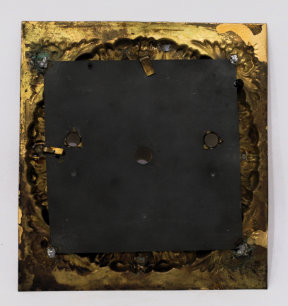
240. $2500
Aaron Dodd Crane “Model D Twelve Month Mantel Clock”, ca. 1848. Crane
invented and patented the torsion pendulum clock in New Jersey in 1841; this invention was briefly adopted by Silas B Terry in the
1850’s and led others to develop similar models, including the wildly popular 400-Day German Anniversary Clocks and the Atmos perpetual
clocks that run on changes in air pressure. Crane’s clocks are rare and highly sought. You can find more information on
Crane’s clocks in Ly, American Clocks Vol. 3, pages 176-193, authored by Frederick Shelley. This model is 21 inches tall in
an ebonized or black lacquer finish with four full columns and metal capitals and plinths. There is no ornamentation on the
front, as is found on some examples, and no evidence of there ever being applied ornaments. Both glasses are original, the tablet
cut and frosted. The dial surround is embossed metal, the dial is replaced paper and should have a glass cover. The hands
are original. The unusual brass movement is shown on pages 184-185 of the Ly reference, with two large beehive fusees mounted
above movement; it runs 375 days and strikes the hours on a wire gong on the backwall below the movement. Crane also made month
and 8-day models; the pendulum balls differed and varied from a single large ball (early models) to later 3-ball models, all of which
incorporated temperature compensation. This example was a later year-long model with a Boston Clock Co. label, used by Crane
after the Year Clock Co. failed in 1848. It has the improved Year Clock swinging 6-ball pendulum bob (see page 186 of the Ly
reference). Does it run? No, not really. The torsion pendulum spring is a Horolovar replacement, the clock runs
for only a few hours, and a proper spring is not available. Cottone’s sold a similar example last fall for $2600. $2500–$5000.



Antique American Clocks January 2024





